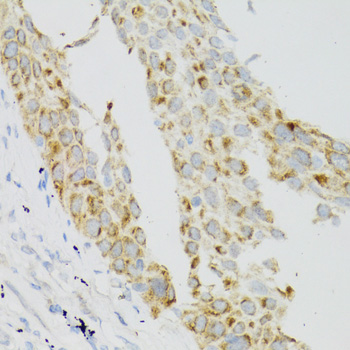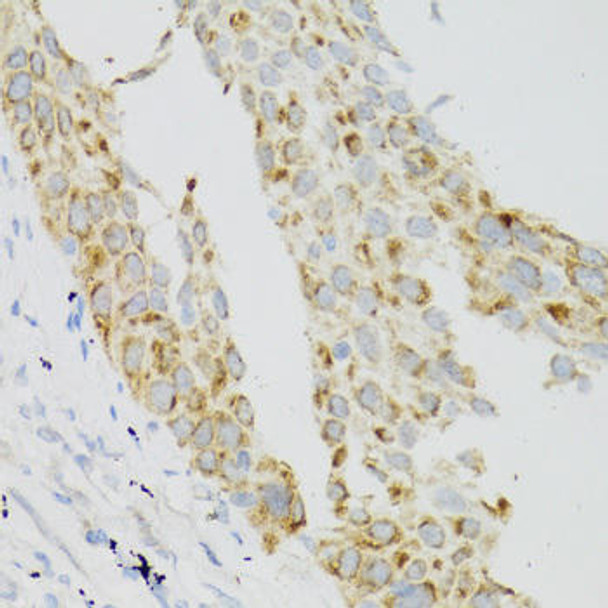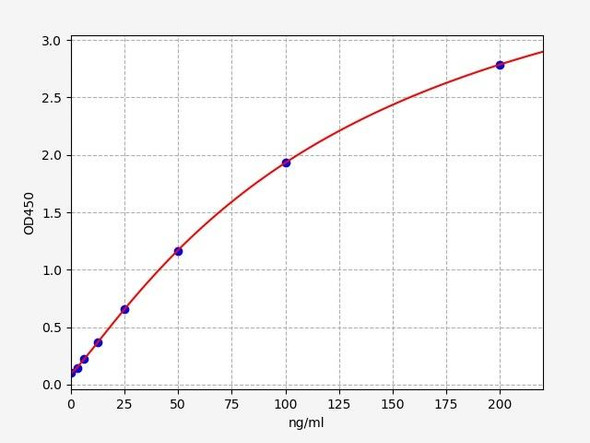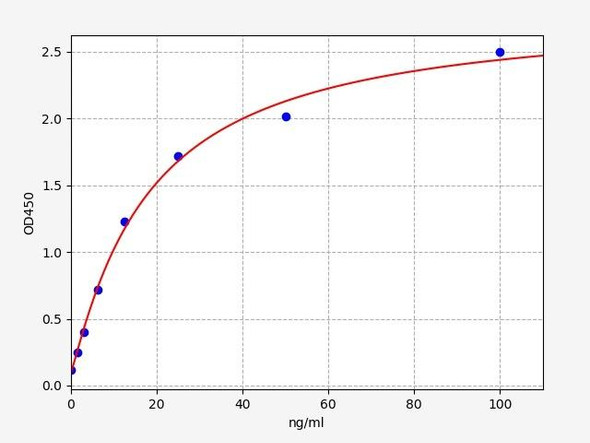Anti-TEK Antibody (CAB0743)
- SKU:
- CAB0743
- Product Type:
- Antibody
- Reactivity:
- Human
- Mouse
- Rat
- Host Species:
- Rabbit
- Isotype:
- IgG
- Antibody Type:
- Polyclonal Antibody
- Research Area:
- Cardiovascular
Description
| Antibody Name: | Anti-TEK Antibody |
| Antibody SKU: | CAB0743 |
| Antibody Size: | 20uL, 50uL, 100uL |
| Application: | WB IHC |
| Reactivity: | Human, Mouse, Rat |
| Host Species: | Rabbit |
| Immunogen: | Recombinant fusion protein containing a sequence corresponding to amino acids 500-750 of human TEK (NP_000450.2). |
| Application: | WB IHC |
| Recommended Dilution: | WB 1:500 - 1:1000 IHC 1:50 - 1:100 |
| Reactivity: | Human, Mouse, Rat |
| Positive Samples: | Mouse kidney, Rat kidney |
| Immunogen: | Recombinant fusion protein containing a sequence corresponding to amino acids 500-750 of human TEK (NP_000450.2). |
| Purification Method: | Affinity purification |
| Storage Buffer: | Store at -20'C. Avoid freeze / thaw cycles. Buffer: PBS with 0.02% sodium azide, 50% glycerol, pH7.3. |
| Isotype: | IgG |
| Sequence: | EIVT LNYL EPRT EYEL CVQL VRRG EGGE GHPG PVRR FTTA SIGL PPPR GLNL LPKS QTTL NLTW QPIF PSSE DDFY VEVE RRSV QKSD QQNI KVPG NLTS VLLN NLHP REQY VVRA RVNT KAQG EWSE DLTA WTLS DILP PQPE NIKI SNIT HSSA VISW TILD GYSI SSIT IRYK VQGK NEDQ HVDV KIKN ATIT QYQL KGLE PETA YQVD IFAE NNIG SSNP AFSH ELVT LPES QAPA DLGG GKML LIA |
| Gene ID: | 7010 |
| Uniprot: | Q02763 |
| Cellular Location: | Cell junction, Cell membrane, Cytoplasm, Secreted, Single-pass type I membrane protein, cytoskeleton, focal adhesion |
| Calculated MW: | 109kDa/121kDa/125kDa |
| Observed MW: | Refer to figures |
| Synonyms: | TEK, CD202B, GLC3E, TIE-2, TIE2, VMCM, VMCM1, Tie2 |
| Background: | This gene encodes a receptor that belongs to the protein tyrosine kinase Tie2 family. The encoded protein possesses a unique extracellular region that contains two immunoglobulin-like domains, three epidermal growth factor (EGF)-like domains and three fibronectin type III repeats. The ligand angiopoietin-1 binds to this receptor and mediates a signaling pathway that functions in embryonic vascular development. Mutations in this gene are associated with inherited venous malformations of the skin and mucous membranes. Alternative splicing results in multiple transcript variants. Additional alternatively spliced transcript variants of this gene have been described, but their full-length nature is not known. |
| UniProt Protein Function: | TIE2: a receptor tyrosine kinase of the Tie family. Receptor for angiopoietin 1. Expressed almost exclusively in endothelial cells. May constitute the earliest mammalian endothelial cell lineage marker. Appears to be critical for endothelial cell-smooth muscle cell communication in venous morphogenesis. TEK is closely related to the TIE receptor tyrosine kinase. |
| UniProt Protein Details: | Protein type:Protein kinase, TK; Protein kinase, tyrosine (receptor); EC 2.7.10.1; Kinase, protein; Membrane protein, integral; TK group; Tie family Chromosomal Location of Human Ortholog: 9p21 Cellular Component: microvillus; focal adhesion; cell surface; basolateral plasma membrane; integral to plasma membrane; extracellular region; actin filament; intercellular junction; lipid raft; perinuclear region of cytoplasm; apical plasma membrane; stress fiber; basal plasma membrane; plasma membrane Molecular Function:protein binding; growth factor binding; protein-tyrosine kinase activity; receptor activity; transmembrane receptor protein tyrosine kinase activity; ATP binding; protein kinase activity Biological Process: response to peptide hormone stimulus; peptidyl-tyrosine phosphorylation; response to cAMP; heart development; protein amino acid autophosphorylation; cell-matrix adhesion; positive regulation of cytokine secretion during immune response; signal transduction; cell-cell adhesion; cell-cell signaling; positive regulation of focal adhesion formation; angiogenesis; endochondral ossification; organ regeneration; Tie receptor signaling pathway; regulation of establishment and/or maintenance of cell polarity; positive regulation of phosphoinositide 3-kinase activity; positive regulation of peptidyl-serine phosphorylation; protein oligomerization; positive regulation of phosphoinositide 3-kinase cascade; positive regulation of protein kinase B signaling cascade; negative regulation of angiogenesis; positive regulation of angiogenesis; positive regulation of protein import into nucleus; response to estrogen stimulus; negative regulation of inflammatory response; endothelial cell proliferation; response to hypoxia; positive regulation of endothelial cell proliferation; regulation of vascular permeability; sprouting angiogenesis; positive regulation of protein amino acid phosphorylation; blood coagulation; leukocyte migration; transmembrane receptor protein tyrosine kinase signaling pathway; negative regulation of apoptosis Disease: Venous Malformations, Multiple Cutaneous And Mucosal |
| NCBI Summary: | The TEK receptor tyrosine kinase is expressed almost exclusively in endothelial cells in mice, rats, and humans. This receptor possesses a unique extracellular domain containing 2 immunoglobulin-like loops separated by 3 epidermal growth factor-like repeats that are connected to 3 fibronectin type III-like repeats. The ligand for the receptor is angiopoietin-1. Defects in TEK are associated with inherited venous malformations; the TEK signaling pathway appears to be critical for endothelial cell-smooth muscle cell communication in venous morphogenesis. TEK is closely related to the TIE receptor tyrosine kinase. [provided by RefSeq, Jul 2008] |
| UniProt Code: | Q02763 |
| NCBI GenInfo Identifier: | 218511853 |
| NCBI Gene ID: | 7010 |
| NCBI Accession: | Q02763.2 |
| UniProt Secondary Accession: | Q02763,Q5TCU2, Q8IV34, A8K6W0, B4DH20, B4DHD3, D3DRK5 E7EWI2, |
| UniProt Related Accession: | Q02763 |
| Molecular Weight: | 60.2kD |
| NCBI Full Name: | Angiopoietin-1 receptor |
| NCBI Synonym Full Names: | TEK tyrosine kinase, endothelial |
| NCBI Official Symbol: | TEK |
| NCBI Official Synonym Symbols: | TIE2; VMCM; TIE-2; VMCM1; CD202B |
| NCBI Protein Information: | angiopoietin-1 receptor; hTIE2; p140 TEK; soluble TIE2 variant 1; soluble TIE2 variant 2; endothelial tyrosine kinase; tyrosine-protein kinase receptor TEK; tunica interna endothelial cell kinase; tyrosine-protein kinase receptor TIE-2; tyrosine kinase with Ig and EGF homology domains-2 |
| UniProt Protein Name: | Angiopoietin-1 receptor |
| UniProt Synonym Protein Names: | Endothelial tyrosine kinase; Tunica interna endothelial cell kinase; Tyrosine kinase with Ig and EGF homology domains-2; Tyrosine-protein kinase receptor TEK; Tyrosine-protein kinase receptor TIE-2; hTIE2; p140 TEK |
| Protein Family: | Angiopoietin-1 receptor |
| UniProt Gene Name: | TEK |
| UniProt Entry Name: | TIE2_HUMAN |
 | Immunohistochemistry of paraffin-embedded human lung cancer using TEK antibody (CAB0743) at dilution of 1:100 (40x lens). |






